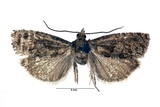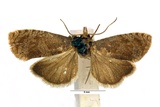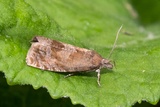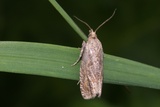Epiblema turbidana (Treitschke, 1835) Species
Last modified: Nov. 23, 2025, 6:26 p.m.
A very rare and local species in Belgium, never found far from it's host plant.
Details
- Classification
- Family: Tortricidae > Subfamily: Olethreutinae > Tribus: Eucosmini > Genus: Epiblema > Species: Epiblema turbidana
- Vernacular names
- Hoefbladzadelmot (NL), Butterbur Bell, Butterbur Root-borer (EN), Pestwurz-Wickler (DE)
- First mention in Belgium
- Dufrane A. 1955. Microlépidoptères de la faune belge. (7e note). — Bulletin de l'Institut royal des Sciences naturelles de Belgique 31(33): 1–12. On page 3.
- Status
-
Native
Distribution
Imago
Wingspan 16–22 mm. A well marked moth but without an outstanding character. It shows a weak ocellus, costal strigulae, a large tornal patch and a basal patch. The overall colour varies from a light orange brown to a dark fuscous. Males have a prominent costal fold to one half.
Bionomics
The larvae feed from a silken tube in the crown or in the roots on the host plant where they hibernate. The pupation follows in a cocoon in the soil.
The adults are active in the afternoon and evening and later come to light.
Flight periods
The adults have been observed from half May towards mid-July.
Observed on
- Host plant (species):
- Petasites hybridus and Petasites albus
The larva lives on Petasitis.
Habitat
It occurs in suitable localities where the food plant occurs.





